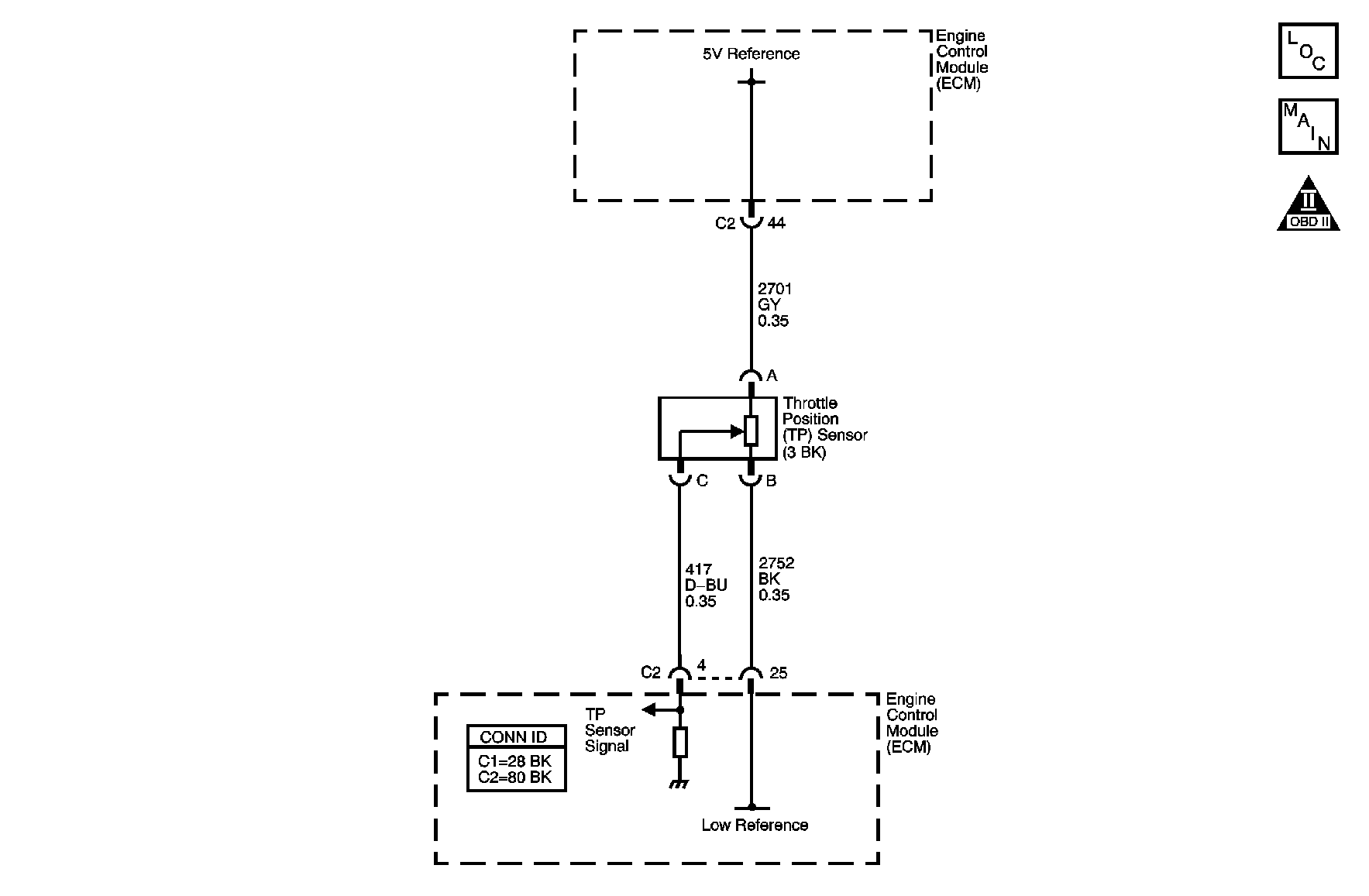
Circuit Description
The throttle position (TP) sensor is used by the engine control module (ECM) to determine the throttle plate angle for various engine management systems. The TP sensor is a potentiometer type sensor with the following three circuits:
| • | A 5-volt reference |
| • | A low reference |
| • | A TP sensor signal |
The ECM provides the TP sensor with 5 volts on the 5-volt reference circuit and a ground on the low reference circuit. Rotation of the TP sensor rotor from the closed throttle position to the wide open throttle (WOT) position provides the ECM with a signal voltage from less than 1 volt to more than 4 volts through the TP sensor signal circuit. If the ECM detects an excessively high signal voltage, DTC P0123 sets.
Conditions for Running the DTC
The engine is running.
Conditions for Setting the DTC
The ECM detects that the TP sensor voltage is more than 4.8 volts for more than 10 seconds.
Action Taken When the DTC Sets
| • | The control module illuminates the malfunction indicator lamp (MIL) when the diagnostic runs and fails. |
| • | The control module records the operating conditions at the time the diagnostic fails. The control module stores this information in the Freeze Frame/Failure Records. |
Conditions for Clearing the MIL/DTC
| • | The control module turns OFF the malfunction indicator lamp (MIL) after 3 consecutive ignition cycles that the diagnostic runs and does not fail. |
| • | A current DTC, Last Test Failed, clears when the diagnostic runs and passes. |
| • | A history DTC clears after 40 consecutive warm-up cycles, if no failures are reported by this or any other emission related diagnostic. |
| • | Clear the MIL and the DTC with a scan tool. |
Test Description
The number below refers to the step number on the diagnostic table.
Step | Action | Values | Yes | No |
|---|---|---|---|---|
Schematic Reference: Engine Controls Schematics Connector End View Reference: Engine Controls Connector End Views or Engine Control Module Connector End Views | ||||
1 | Did you perform the Diagnostic System Check-Engine Controls? | -- | Go to Step 2 | |
2 |
Is DTC P0641 also set? | -- | Go to DTC P0641 | Go to Step 3 |
3 | Observe the TP Sensor parameter with the scan tool. Is the voltage more than the specified value? | 4.8 V | Go to Step 5 | Go to Step 4 |
4 |
Did the DTC fail this ignition? | -- | Go to Step 5 | Go to Intermittent Conditions |
5 | Test for an intermittent and for a poor connection at the TP sensor. Refer to Testing for Intermittent Conditions and Poor Connections and Connector Repairs in Wiring Systems. Did you find and correct the condition? | -- | Go to Step 13 | Go to Step 6 |
Is the voltage less than the specified value? | 0.2 V | Go to Step 7 | Go to Step 8 | |
7 |
Is the voltage more than the specified value? | 0.2 V | Go to Step 9 | Go to Step 11 |
8 | Test the TP sensor signal circuit between the engine control module (ECM) and the TP sensor for a short to voltage. Refer to Circuit Testing and Wiring Repairs in Wiring Systems. Did you find and correct the condition? | -- | Go to Step 13 | Go to Step 12 |
9 | Test the low reference circuit between the ECM and the TP sensor for an open or for high resistance. Refer to Circuit Testing and Wiring Repairs in Wiring Systems. Did you find and correct the condition? | -- | Go to Step 13 | Go to Step 10 |
10 | Test for an intermittent and for a poor connection at the ECM. Refer to Testing for Intermittent Conditions and Poor Connections and Connector Repairs in Wiring Systems. Did you find and correct the condition? | -- | Go to Step 13 | Go to Step 12 |
11 | Replace the TP sensor. Refer to Throttle Position Sensor Replacement . Did you complete the replacement? | -- | Go to Step 13 | -- |
12 | Replace the ECM. Refer to Engine Control Module Replacement . Did you complete the replacement? | -- | Go to Step 13 | -- |
13 |
Did the DTC fail this ignition? | -- | Go to Step 2 | Go to Step 14 |
14 | Observe the Capture Info with a scan tool. Are there any DTCs that have not been diagnosed? | -- | System OK | |
